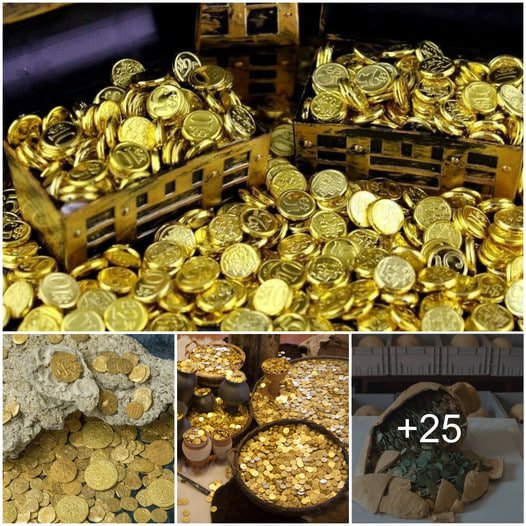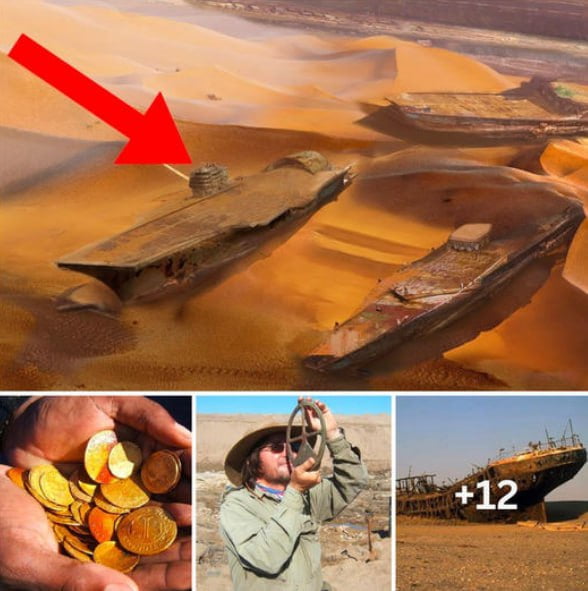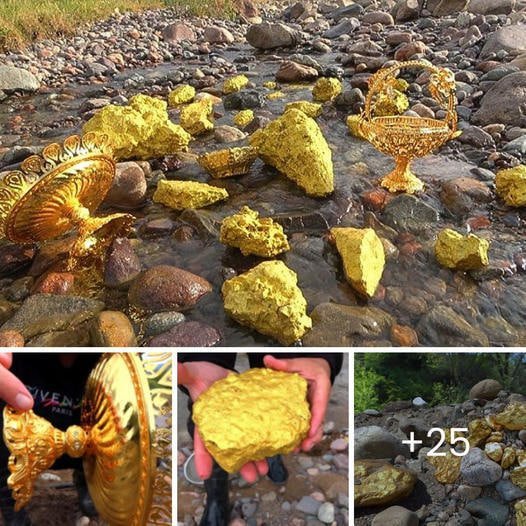In Norway, an amateur metal detector enthusiast recently unearthed what experts are calling the ‘discovery of a lifetime’. Erlend Bore, 51, made the incredible find while searching a farmer’s field on Rennesoey island near Stavanger in late August. Initially thinking he had stumbled upon chocolate coins, Bore was stunned to uncover nine pendants, three rings, and 10 gold pearls that have been traced back to the time of the fall of the Roman Empire.
This astonishing discovery occurred just months after Bore purchased his first metal detector, following his doctor’s advice to spend more time outdoors. The significance of his find was not lost on Ole Madsen, the director of the Archaeological Museum at the University of Stavanger, who described the find as ‘extremely rare’ and deemed it as the ‘gold find of the century in Norway’.

Eager explorer Erlend Bore proudly stands beside a valuable gold discovery, captured in a photo right after he unearthed it using a trusty metal detector on the scenic island of Rennesoy in Stavanger.

One of the nine exquisite gold pendants unearthed in the ancient grounds of Rennesoy, located in the picturesque city of Stavanger, Norway, on the enchanting date of 06 September 2023.

A necklace adorned with gold pendants resembling coins has been recreated from a stunning collection of gold artifacts unearthed in August 2023 by amateur archaeologist Mr. Bore.

In Stavanger, archaeologists are currently excavating a site on Rennesoy Island where a gold treasure was uncovered by an amateur with a metal detector on August 30. Mr. Bore stumbled upon the treasure while exploring the mountainous island with his metal detector. Initially discovering some scrap metal, he then unearthed something truly remarkable – a treasure weighing just over 100 grams. In Norway, items predating 1537 and coins older than 1650 are considered state property and must be surrendered.
Associate professor Hakon Reiersen revealed that the gold pendants found, called bracteates, date back to around 500 AD during Norway’s Migration Period. These pendants, along with gold pearls, were part of an extravagant necklace crafted by skilled jewelers for the society’s elite. This discovery is incredibly rare, with no similar finds in Norway since the 19th century.
Professor Sigmund Oehrl, an expert on such pendants, mentioned that approximately 1,000 golden bracteates have been discovered in Norway, Sweden, and Denmark. These pendants typically depict symbols like the Norse god Odin healing his son’s horse. On the Rennesoy pendants, a horse with a protruding tongue is depicted, symbolizing illness and distress but also hope for recovery and renewal.
The Archaeological Museum in Stavanger, located around 200 miles southwest of Oslo, intends to showcase Mr. Bore’s discoveries. In a separate discovery, Israeli archaeologists recently found four rare Roman swords in a cave near the Dead Sea. These weapons are believed to be from the Bar Kokhba Revolt in 132-135 AD, potentially taken from Roman soldiers by Jewish rebels and hidden for almost 2,000 years.

At the University of Stavanger’s Archaeological Museum in Norway, Conservator Hege Hollund proudly displays a remarkable discovery of gold on September 6, 2023.

The discovery of gold at the University of Stavanger’s Archaeological Museum in Stavanger, Norway, on September 6, 2023.

A photograph provided by the Archaeological Museum showcases one of the ten pearls unearthed at Rennesoy, located in Stavanger, Norway, on September 6, 2023.

In the Archaeological Museum at the University of Stavanger, Professor Sigmund Oehrl is examining a fascinating gold discovery on display. This discovery dates back to the migratory period, when Germanic tribes were moving north due to the spread of the Huns across Europe.
During this time, these tribes established power structures under local chieftains, leading to the construction of Norway’s earliest forts. By the 8th century, these groups had gained enough strength to launch successful conquests in Britain.
The first known Norwegian coin, minted in Norway, is a penny attributed to Olav Tryggvason and dates back to 1000 AD. Norway’s early history shows a reliance on imported foreign currencies, as the country did not have its own mint for a long time.




